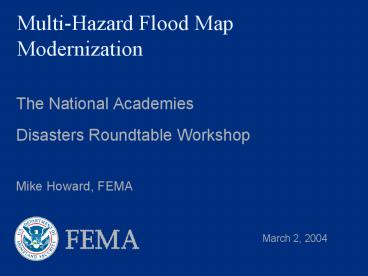MultiHazard Flood Map Modernization - PowerPoint PPT Presentation
1 / 21
Title:
MultiHazard Flood Map Modernization
Description:
Transition to Digital Maps Online. 17. March 2004. Coastal Methodology Assessment ... Digital Maps Online. Scanned inventory of existing paper maps in 2002 ... – PowerPoint PPT presentation
Number of Views:91
Avg rating:3.0/5.0
Title: MultiHazard Flood Map Modernization
1
Multi-Hazard Flood Map Modernization
- The National Academies
- Disasters Roundtable Workshop
- Mike Howard, FEMA
March 2, 2004
2
Supporting Agency Strategic Goals
- Multi-Hazard Flood Map Modernization will
- Facilitate planning and prevention efforts
- Reduce loss of life and property
- Minimize suffering and disruption caused by
disasters - Provide a component of the emergency management
information portal - Enable Multi-Hazard risk identification and
mitigation planning
3
Multi-Hazard Flood Map Modernization Vision
- Network the nation using Internet portal
technology - Easy access to digital flood hazard risk
information - Connecting all levels of government community
map ownership - Leverage the use of Federal, State, and local
resources - Cooperating Technical Partners (CTP) Program
- Business Planning Process
- Reduce processing time and costs for map updates
- Increase accountability for spending with
results-oriented systems - Standards allow seamless data flow among partners
- Increase partners, stakeholders, users
understanding of flood hazards and risks - Communicate widely, effectively, consistently,
and continuously - Enable Multi-Hazard Risk Identification and
Management
4
Multi-Hazard Flood Map Modernization
- Business Planning Process
- National Level FEMA HQ and National Service
Provider - Reflected in National Business Plan OMB Exhibit
300 - Regional Level FEMA Regional Offices
- Reflected in Regional Business Plans
- State/Local Level Flood Hazard Mapping
Partners - Reflected in State Business Plans
- Program-Wide Monitoring of Cost and Schedule
5
Overview
Program NEXT
Program NOW
Map production cycle time 5 years or more
Map production cycle less than 3 years
Centralized data collection/ ownership of flood
map data (FEMA does mapping)
Decentralized data collection/ownership of flood
map data
Outdated maps
All 20,000 communities digitally mapped
Flood data only
Enable access to Multi-Hazard data
Limited Leverage of CTP Funds
Increased CTP leverage more qualified CTPs
Many at-risk properties are uninsured
NFIP coverage for all at risk users informed
Decreasing public spent on flood emergencies
Better/more responsible flood plain management
Increased Trust
6
Data Sharing
- Maximize the use of existing data
- Maximize the data that can be published in the
public domain - Maximize the ability for users of the Map Mod
Portal to find existing data - Maximize cost sharing with partners for data
acquisition - Minimize the burden on States and locals for
coordination on data - Maximize the use of standards to make data
reusable.
7
Digital FIRM Layers
Special Flood Hazard Areas
Land Ownership
Transportation
Surface Waters
Boundaries
Geodetic Control
Elevation
Aerial Imagery
8
Program NEXT Analysis and Modeling
Special Flood Hazard Areas
Repetitive Loss
Critical Infrastructure
Structures
Aerial Imagery
9
Real-Time Inundation Mapping
10
Three Parts of a Successful System
11
Management Information Portal (MIP) Conceptual
Construct
- Key Concepts
- Open distributed network
- Captures intermediate data and makes it available
for other applications - Provides tailored interfaces
- Includes workflow processes
- Tools and workflow processes are integrated
- Provides Program Management tools
This construct allows division of IT into
manageable parts. It also helps focus on items of
key importance.
12
Tools available for Mapping Partners
13
Data Capture Points
Mapping / DFIRM Production
Field Survey
Base Map
DFIRM Database
Terrain Development
Scoping
Engineering
Review
Current Capture Points
MOD TEAM Data Capture Points
14
MIP Users Span the Community
15
Other MIP Functions
Collaboration
National Flood Layer
Repository
Performance Management
Data Sharing
Knowledge Management
Enable Partnering
Outreach
Learning
Geospatial One-Stop
EVMS
Risk Education
Collect metrics for BPI
16
Other Initiatives
- Coastal Methodology Assessment
- Transition to Digital Maps Online
17
Coastal Methodology Assessment
- Objectives
- Evaluate and update guidelines for analyzing and
mapping coastal flood hazards on the Atlantic and
Gulf Coasts - Develop guidelines for the Pacific Coast
- Implement new guidelines for FY 2005
18
Coastal Methodology Assessment
- Project Initiated
- October 2003
- Phase 1
- Evaluate the existing guidelines as they apply to
all three major coastlines (May 2004) - Phase 2
- Develop new draft guidelines for the Pacific
Coast (October 2004)
19
Coastal Methodology Assessment
- Participants
- A team of technical experts with experience in
various coastal processes and their effects in
different geographic regions of the country - Federal agencies
- academic institutes
- engineering firms
20
Digital Maps Online
- Scanned inventory of existing paper maps in 2002
- Viewing tool allows users to view and print
8.5x11 portion of map on typical home computer - Requests from general public for paper maps
reduced by 50 - Eliminated need for 500,000 paper maps per year
- Map Mod will produce on-line GIS data
21
(No Transcript)































